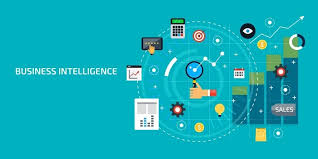Hello!
 Business intelligence (BI) is part of business data science and pertains to businesses’ accumulated knowledge and methods to analyze business data. Business managers use these business data for various purposes, including competitive analysis, market research, decision making, infrastructure planning, and many more.
Business intelligence (BI) is part of business data science and pertains to businesses’ accumulated knowledge and methods to analyze business data. Business managers use these business data for various purposes, including competitive analysis, market research, decision making, infrastructure planning, and many more.
There are three stages in the development of modern business intelligence. The first is research and development, which involves collecting, organizing, and analyzing information.
The second stage is synthesizing the collected data and making sense of it through various analytical techniques, like sentiment analysis,predictive analysis, and prescriptive analysis. The third and most crucial stage is to test the synthesis results through various practical applications.
To further understand how you can use the data for your business. You need to develop a business intelligence roadmap. This article will help you know what a business intelligence roadmap is and how you can design one for your business.
What is A Business Intelligence Roadmap?
 A business intelligence roadmap describes the actions you take to apply business intelligence in your organization. It goes from identifying the drivers to delving into the BI methodology, identifying the top threats and defining the strategic objectives, monitoring the current situation, and developing the performance metrics to help you measure your commitments.
A business intelligence roadmap describes the actions you take to apply business intelligence in your organization. It goes from identifying the drivers to delving into the BI methodology, identifying the top threats and defining the strategic objectives, monitoring the current situation, and developing the performance metrics to help you measure your commitments.
When you design a business intelligence roadmap, it should identify the drivers of change and identify the opportunities available to you.
The roadmap should also be able to forecast where industry resources might be most helpful. And, it should provide a framework for your BI strategy and your overall business strategy. A good design starts by analyzing the present state of your company and what threats are most likely to impact you and your future.
Data science, especially real-time data mining, is the backbone of modern business intelligence. This discipline seeks to mine unstructured data sets efficiently to provide timely insights. It uses scientific programming languages for structured extraction and analysis of the relevant data.
Data mining techniques help to construct filters or complex programs for supervised or unsupervised data mining. Data mining provides valuable insights, which are used to build better business intelligence products and services.
 Why is a business intelligence roadmap necessary? As part of your implementation, a comprehensive roadmap should address the following questions:
Why is a business intelligence roadmap necessary? As part of your implementation, a comprehensive roadmap should address the following questions:
- What are the drivers of change?
- What are the drivers of opportunity?
- Who can I serve with this project?
- How can I best use the resources available to me?
- What are the potential obstacles?
How Do You Create A Business Intelligence Roadmap?
 A well-constructed business intelligence roadmap clearly outlines your goals and provides a benchmark against which to compare your current results. A well-formulated road map is a key to success when it comes to implementing business intelligence. It not only identifies the current status of your analytics tools and data, but it provides you with a framework to work within.
A well-constructed business intelligence roadmap clearly outlines your goals and provides a benchmark against which to compare your current results. A well-formulated road map is a key to success when it comes to implementing business intelligence. It not only identifies the current status of your analytics tools and data, but it provides you with a framework to work within.
Here are essential steps you need to do to develop an effective business intelligence roadmap:
1. Start With Your Business Vision
 One of the first things that must be included on any intelligence roadmap is goals and objectives. You need to have clearly defined goals that you can achieve over the long term. This will ensure that every action taken under the roadmap has a direct purpose.
One of the first things that must be included on any intelligence roadmap is goals and objectives. You need to have clearly defined goals that you can achieve over the long term. This will ensure that every action taken under the roadmap has a direct purpose.
Your business goals and objectives should be defined in your business vision. A business vision is a combination of your company’s purpose and direction, and it should be used as the basis for many crucial decisions regarding your business intelligence strategy.
Your vision will also explain to the people in the organization what their roles are and why it’s important that they do their respective jobs excellently.
2. Evaluate Your Current Situation
To develop strategies to reach your vision, you must have a baseline. It’s important to know where your business currently stands for gathering, sharing, and analyzing business intelligence data.
 Who provides the critical data used by the marketing team? What is the crucial data stored in your business intelligence system? To answer these types of questions, you need to talk to all those involved in the current business intelligence process.
Who provides the critical data used by the marketing team? What is the crucial data stored in your business intelligence system? To answer these types of questions, you need to talk to all those involved in the current business intelligence process.
Once you have all the answers, you should compile a strength, weaknesses, opportunities, and threats or SWOT analysis. A good SWOT analysis is a detailed planning framework that a company can utilize to identify strengths, weaknesses, opportunities, and risks of specific strategic initiatives.
Your SWOT analysis will help you in your next stage of business intelligence roadmap development.
3. Establish How You’ll Define And Implement Your BI Structure
Your business intelligence roadmap should also include BI governance that will define and implement your proposed BI structure. It should consist of all the people responsible for gathering and analyzing business intelligence data, and the tools needed to manage the data.
 The members of the BI governance must understand their roles and the relationships of the different structures in the company. It’s best to include people from different levels as they’ll be considered as representatives from other company areas.
The members of the BI governance must understand their roles and the relationships of the different structures in the company. It’s best to include people from different levels as they’ll be considered as representatives from other company areas.
It’s also essential to use BI tools that are appropriate for your business structure. Lastly, it’s also essential to define how data should be presented so they’ll be consistent on all reporting levels.
4. Identify Key Performance Indicators
Another essential element of a business intelligence roadmap is your key performance indicators or KPIs. These are measurable values that show how effectively a business is achieving its goals. The KPIs should sit at the core of your BI roadmap, and they’ll help you evaluate if your strategies are keeping you on the right track or if improvements have to be made.
5. Document And Ensure Continuous Monitoring Of BI Strategies
Once you have everything set, you should properly document and monitor all aspects of your business intelligence roadmap. After documenting your vision, goals, and KPIs, it’s also essential that you need to ensure continuous monitoring to check if you need to make necessary changes on your roadmap.
Final Thoughts
 Data science is of utmost importance, especially in business intelligence. Developing a business intelligence dashboard is a gradual process of constantly analyzing your current situation and making a series of critical decisions.
Data science is of utmost importance, especially in business intelligence. Developing a business intelligence dashboard is a gradual process of constantly analyzing your current situation and making a series of critical decisions.
Your business intelligence roadmap should comprise the information necessary for you to make an informed decision about what strategic changes are required, how to implement those changes, and how to monitor and track changes.
Therefore, your business intelligence roadmap should be based on your business vision and goals.
To create effective strategies in reaching these goals, you need to evaluate your current situation with a SWOT analysis.
Once you’ve analyzed your current situation, you should develop plans for business intelligence governance and the KPIs you should document and monitor to check the effectiveness of your strategies. All of these will be critical in creating a business intelligence roadmap that effectively reaches your business goals.
Thank you!
Subscribe to our newsletter! Join us on social networks!
See you!






